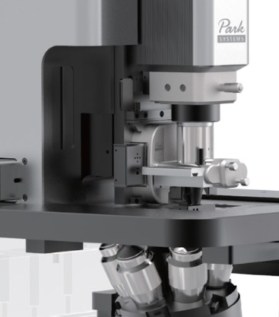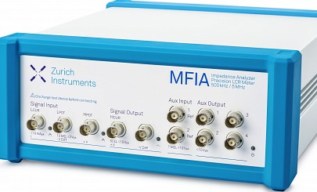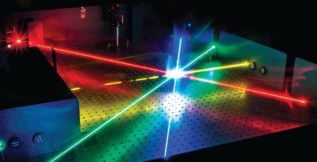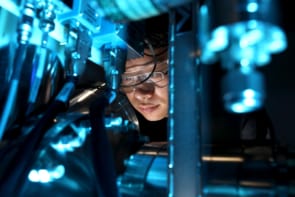
At this week’s meeting of the Materials Research Society in Boston, US, scientists from all over the world will be sizing up the latest equipment for materials characterization. Here’s a few of the highlights.
Combined microscope offers flexibility at the nanoscale
An affordable and versatile platform for analytical chemistry and electrochemistry has just been released by Park Systems. The Park NX12 combines an inverted optical microscope (IOM) with an atomic force microscope to enable advanced research on materials such as membranes, organic devices and electronics, and biological and pathological samples.
 “We just purchased the Park NX12 because we wanted a research-grade platform for AFM and scanning-ion conductance microscopy (SICM) that was also easy to use,” commented Dr Yixian Wang at the California State University in Los Angeles. “The Park NX12 was the only comprehensive platform that could perform all scanning probe techniques – including pipette-based SICM – while also utilizing IOM for the nanoscale measurement flexibility we needed. We are happy with a very affordable product with so many features and such accurate data.”
“We just purchased the Park NX12 because we wanted a research-grade platform for AFM and scanning-ion conductance microscopy (SICM) that was also easy to use,” commented Dr Yixian Wang at the California State University in Los Angeles. “The Park NX12 was the only comprehensive platform that could perform all scanning probe techniques – including pipette-based SICM – while also utilizing IOM for the nanoscale measurement flexibility we needed. We are happy with a very affordable product with so many features and such accurate data.”
According to Park Systems, the NX12 is ideally suited for multi-user facilities, with a modular design that lends itself to further development. It has also been designed to handle the pipette probes commonly used to study the electrochemistry of transparent materials such as nanopore membranes for fuel cells and biomembranes.
Impedance measurements benefit from precision
A powerful impedance analyser from Zurich Instruments offers precision measurements of electrical parameters such as capacitance, inductance and resistance at frequencies ranging from DC to 5 MHz. The MFIA digital impedance analyser offers a guaranteed accuracy of 0.05% over a measurement range from 1 mΩ to 1 TΩ. With excellent repeatability and a small temperature drift, the MFIA addresses the shortcomings of legacy impedance analysers, and offers a number of innovations for materials researchers – without the need for any additional software to be installed.
 The MFIA combines an impedance analyser with a precision LCR meter. While the LCR meter measures impedance parameters at a single frequency, an impedance analyser can sweep the frequency and graphically display the acquired parameters. For a hands-on demo, visit Zurich Instruments at booth #1308 at this week’s MRS Fall.
The MFIA combines an impedance analyser with a precision LCR meter. While the LCR meter measures impedance parameters at a single frequency, an impedance analyser can sweep the frequency and graphically display the acquired parameters. For a hands-on demo, visit Zurich Instruments at booth #1308 at this week’s MRS Fall.
Laser lights up nanophotonics research
A tunable continuous-wave laser from HÜBNER Photonics has been specifically designed for demanding applications in nanophotonics, atomic physics, and quantum optics. The high-precision C-WAVE laser delivers single-frequency radiation in the 450–650 nm and 900–1300 nm ranges, with output powers reaching 200 mW at visible wavelengths and 400 mW in the near infrared.
 “A vast number of experimental studies call for high-quality CW laser light that is tunable throughout the visible spectrum, but it is not straightforward to cover this region with most common tunable laser designs” says Korbinian Hens, a product manager for HÜBNER Photonics. “Sources based on CW optical parametric oscillator (OPO) technology have become commercially available relatively recently, and are quickly gaining popularity.”
“A vast number of experimental studies call for high-quality CW laser light that is tunable throughout the visible spectrum, but it is not straightforward to cover this region with most common tunable laser designs” says Korbinian Hens, a product manager for HÜBNER Photonics. “Sources based on CW optical parametric oscillator (OPO) technology have become commercially available relatively recently, and are quickly gaining popularity.”
The C-WAVE, which exploits OPO technology to generate tunable CW laser light across a wide range of wavelengths, is ideal for experiments that require narrow linewidths with moderate output powers. It can be used, for example, to obtain fluorescence excitation spectra of single molecules in a solid-state crystal, or excitation energy-dependent Raman spectra of a mixture of single-wall carbon nanotubes.
“Tunable CW OPOs offer a competitive alternative to conventional lasers and related technologies, in particular for experimental studies in molecular physics and quantum nanophotonics,” comments HÜBNER Photonics’ Jaroslaw Sperling. “We can predict further applications and increasingly sophisticated experimental approaches, including state-of-the-art methodologies in Raman scattering of single molecules.”
Visit the Physics World Buyer’s Guide to find the best technology and supplier for your next scientific project.



